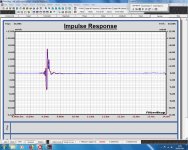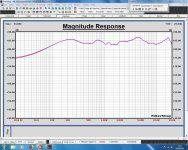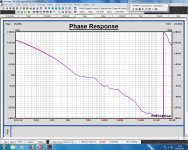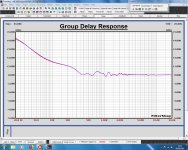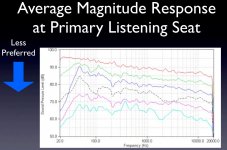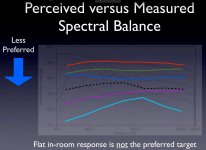I did this exact same test with a loudspeaker crossover change. Change - better - change again - better, change back to the original - better still. Its just one big circle.
hahaha, that's so true. 🙂
Well, probably it's time to remove my high Q dip again. 😀
Thanks Mitch,
right on the money with good references. I am so far out of this loop anymore that I don't know what's out there. But I have found that nothing coming along surprises me and that what I have done for decades still stands as a premium solution.
right on the money with good references. I am so far out of this loop anymore that I don't know what's out there. But I have found that nothing coming along surprises me and that what I have done for decades still stands as a premium solution.
But if the system is CD, then tilting the power means tilting the axial as well.
No system that i know of has constant directivity at all frequencies. In 99.99% power response will have some downward tilt from 100Hz to 10000Hz. There are few exotic solutions (true omnidirectivity) but i haven't even seen them let alone listened them. There you can tilt listening axis response because it is all the same.
Last edited:
The baffle step effect is not so low in frequency that it cannot be measured by DIY. I did all my measurements in my living room with DIY equipment.
In a typical home environment one can get anechoic farfield data down to about 300 Hz. This is also the frequency resolution of the SPL curve, so you will get frequency bins centred at 300 Hz, 600 Hz, 900 Hz, etc. Depending on the baffle size, the baffle step is centered at a few hundred Hz, and may easily extend down to 100 Hz. Under these circumstances it is not possible to completely capture the SPL curve over the full frequency range where the baffle step is happening.
Ben,
In response to your post #68, the notion of scrambled phase under the conditions you described is so far from that which theory predicts and without giving causal reasons can only lead me to the conclusion that you just couldn’t figure out the cause of the problem. I would suggest that if only for your own edification you go back and try researching this issue with perhaps more applicable instrumentation next time.
In any case I decided to go ahead with tests as described in my post #49 in which I used a KEF LS50 for the measurements together with a Clio microphone spaced at 1metre from the loudspeaker on axis. As you can see from the impulse response, I was able to obtain a reflection free time of about 5mS. This limits the LF accuracy to a little over 200Hz
All the data was recorded via ARTA software, supported by an M-Audio Delta 192 sound card and imported into Filtershop for display purposes with 1/24th Oct. smoothing applied on all but the group delay response where I used 1/6th Oct.
I made two measurements, one at 1 metre and the other at 1metre plus 7.5mm.
Attached are the Impulse, Magnitude, Phase and Group delay responses. As you can see, all response types with the exception of the impulse response have the two measurements completely overlapped. Flight times were subtracted in order to show the true phase and group delay of these responses.
These measurements clearly show that phase does not get scrambled at all as you claimed. There is no logical reason for the phase to get scrambled in any case.
Peter
In response to your post #68, the notion of scrambled phase under the conditions you described is so far from that which theory predicts and without giving causal reasons can only lead me to the conclusion that you just couldn’t figure out the cause of the problem. I would suggest that if only for your own edification you go back and try researching this issue with perhaps more applicable instrumentation next time.
In any case I decided to go ahead with tests as described in my post #49 in which I used a KEF LS50 for the measurements together with a Clio microphone spaced at 1metre from the loudspeaker on axis. As you can see from the impulse response, I was able to obtain a reflection free time of about 5mS. This limits the LF accuracy to a little over 200Hz
All the data was recorded via ARTA software, supported by an M-Audio Delta 192 sound card and imported into Filtershop for display purposes with 1/24th Oct. smoothing applied on all but the group delay response where I used 1/6th Oct.
I made two measurements, one at 1 metre and the other at 1metre plus 7.5mm.
Attached are the Impulse, Magnitude, Phase and Group delay responses. As you can see, all response types with the exception of the impulse response have the two measurements completely overlapped. Flight times were subtracted in order to show the true phase and group delay of these responses.
These measurements clearly show that phase does not get scrambled at all as you claimed. There is no logical reason for the phase to get scrambled in any case.
Peter
Attachments
Last edited:
c
Using a signal which simultaneous presents a few frequencies (a square wave) you would have instantly convinced all of us of what gets to the ear at your two distances (or at least the ear at 1 meter, as you tested). I thought my post was a pretty darn easy to grasp demonstration.
(Esp. convincing since I changed nothing in the sound - just moved the mic a bit, as you requested. The sound didn't change but the phases re-scrambled, eh.)
Why didn't you?
Speaking of theory, if it weren't Saturday afternoon, I'd calculate how many degrees of phase angle a 2kHz wave makes in a meter, and how many for 2.5kHz. Then, I'd calculate phase angle for 1.08 meters...... If it weren't Saturday afternoon, I'd take your posted phase data and add that further bit of scrambling (albeit orderly) to the above confusion.
But why bother calculating just to satisfy somebody's need for theoretical clarity since we probably can't hear the difference anyway, Earl excepted.
B.
It sure would have been a simple matter for you to post 'scope traces like mine.Ben,
In response to your post #68, the notion of scrambled phase under the conditions you described is so far from that which theory predicts and without giving causal reasons can only lead me to the conclusion that you just couldn’t figure out the cause of the problem....
Using a signal which simultaneous presents a few frequencies (a square wave) you would have instantly convinced all of us of what gets to the ear at your two distances (or at least the ear at 1 meter, as you tested). I thought my post was a pretty darn easy to grasp demonstration.
(Esp. convincing since I changed nothing in the sound - just moved the mic a bit, as you requested. The sound didn't change but the phases re-scrambled, eh.)
Why didn't you?
Speaking of theory, if it weren't Saturday afternoon, I'd calculate how many degrees of phase angle a 2kHz wave makes in a meter, and how many for 2.5kHz. Then, I'd calculate phase angle for 1.08 meters...... If it weren't Saturday afternoon, I'd take your posted phase data and add that further bit of scrambling (albeit orderly) to the above confusion.
But why bother calculating just to satisfy somebody's need for theoretical clarity since we probably can't hear the difference anyway, Earl excepted.
B.
Last edited:
The money shot is on slide 24 and a very interesting phenomena about how we perceive in-room frequency response on slide 25. The tilted in-room response is perceived by our ears/brain as flat or neutral.
Attachments
...the phases re-scrambled
After reading the all this discussion I get more and more confused about what the term "scrambled phase". Maybe it's because I am not a native English speaker, but what exactly do you mean by this? Can you explain the meaning of "scrambled phase" using established engineering terminology?
Ben,
The reason I chose the instruments I used to make these tests was quite simply because many DIYAUDIO members have very similar instruments which enables them to verify these measurements for themselves, even down to owners of KEF LS50 loudspeakers of which I assume there are many. But to be frank Ben, why would I use a test method like yours when I believe it to indicate erroneous results!
Peter
The reason I chose the instruments I used to make these tests was quite simply because many DIYAUDIO members have very similar instruments which enables them to verify these measurements for themselves, even down to owners of KEF LS50 loudspeakers of which I assume there are many. But to be frank Ben, why would I use a test method like yours when I believe it to indicate erroneous results!
Peter
After reading the all this discussion I get more and more confused about what the term "scrambled phase". Maybe it's because I am not a native English speaker, but what exactly do you mean by this? Can you explain the meaning of "scrambled phase" using established engineering terminology?
Um, I see we have a problem. "Engineering terminology" is one framework but "perceptual psychology" is another.
Acoustics can define the stimulus although engineering terms of practical value for engineering purposes may not be the right ones to use for describing or displaying perceptual results. That seems to be Peter's fallacy. An example would be "phase difference between your ears" versus "time difference between your ears". Aren't they equivalent in "engineering" terms?
So the point is, if the hearing system can use phase information (which seems it can't much except maybe lower down in frequency) then it must get that information in a coherent way.
There are interaural time differences whereby the sound of an object off to your right arrives later to your left ear. At F-kHz that would be say, 45-degrees later. But at another frequency, that would be some other phase difference or even, heaven forbid, 405-degrees later, eh. The ITD is the same at all frequencies but the phase would be, well, complicated*. (Ditto for ILD.)
In the language of perceptual psychology, you'd think that ITD and ILD are cues to spatial localization which the brain should find reliable and rely upon (esp. after you have learned to correct for the room characteristics). Unlike phase.
B.
* yes I know somebody will want to draw a plot to show it isn't complicated for REW at all (just complicated for meat computers)
Last edited:
NoAn example would be "phase difference between your ears" versus "time difference between your ears". Aren't they equivalent in "engineering" terms?
In a typical home environment one can get anechoic farfield data down to about 300 Hz. This is also the frequency resolution of the SPL curve, so you will get frequency bins centred at 300 Hz, 600 Hz, 900 Hz, etc. Depending on the baffle size, the baffle step is centered at a few hundred Hz, and may easily extend down to 100 Hz. Under these circumstances it is not possible to completely capture the SPL curve over the full frequency range where the baffle step is happening.
I have an unusually large room for a home and I get down to 200 Hz. Which I think is more than enough to capture the baffle effect in the measurement.
Thanks bradleypn, those are great plots. They make the point.
Ben,
The reason I chose the instruments I used to make these tests was quite simply because many DIYAUDIO members have very similar instruments which enables them to verify these measurements for themselves, even down to owners of KEF LS50 loudspeakers of which I assume there are many. But to be frank Ben, why would I use a test method like yours when I believe it to indicate erroneous results!
Peter

It's time to just give up. You know the old saying(s).
Ben you have avoided answering my questions. You seem to be hung up on absolute phase which is not what is being discussed.
Another question. Do you understand what a filter does to a square wave? Anything other than a first order filter will mess it up (even first order will but not as much. What is a square wave? What happens if you hp filter it?). This has nothing to do with the room.
Tony.
Another question. Do you understand what a filter does to a square wave? Anything other than a first order filter will mess it up (even first order will but not as much. What is a square wave? What happens if you hp filter it?). This has nothing to do with the room.
Tony.
Last edited:
Do you understand what a filter does to a square wave? Anything other than a first order filter will mess it up (even first order will but not as much.
Tony.
When I saw the square waveform from my speakers at first time, I seriously felt something was terribly wrong with my speakers. 😀
An example would be "phase difference between your ears" versus "time difference between your ears". Aren't they equivalent in "engineering" terms?
Time and phase are different things. Not equivalent.
...interaural time differences ... ITD is ... phase would be, well, complicated*. (Ditto for ILD.) ... ITD ... Unlike phase.
Ok, this is not my piece of cake. I simply don't understand the meaning of your words. You are welcome to go on, but please don't expect me (and others?) to understand what you are saying.
Let's try to focus on the OP question.
I don't think that anyone really likes flat. Harman has concluded that people prefer a slight HF rolloff, especially for CD sources, and a slight bass boost.
This is not the first time I am reading this, and I would like to read up on this to learn why / how a tilted SPL response is preferred. However, I couldn't figure out the original Harman report / paper / document. Any pointers or references?
But if the system is CD, then tilting the power means tilting the axial as well.
The power response reflects the power radiated from the speaker into the listening environment (covering all directions), so I guess it is a useful indicator of what we hear in a room. The statement above therefore makes a lot of sense to me (assuming "CD" = "constant directivity", not "controlled directivity").
However, aiming for a tilted SPL response seems in contrast to the widely used/accepted approach of "aim for flat SPL response (anechoic, on-axis)". Should we give up on flat on-axis response and aim for power response with a slight downward tilt instead (at least for constant directivity designs)? Or something in between?
The power response reflects the power radiated from the speaker into the listening environment (covering all directions), so I guess it is a useful indicator of what we hear in a room. The statement above therefore makes a lot of sense to me (assuming "CD" = "constant directivity", not "controlled directivity").
However, aiming for a tilted SPL response seems in contrast to the widely used/accepted approach of "aim for flat SPL response (anechoic, on-axis)". Should we give up on flat on-axis response and aim for power response with a slight downward tilt instead (at least for constant directivity designs)? Or something in between?
You've hit the nail on the head here and it's interesting that most people aim for a flat SPL response at 1m on axis and ignore what the speaker is really doing in the listening room for the listeners.
In my experience the best thing to do is to aim for a flat response, as measured in an anechoic chamber, in the first instance. Then check the off-axis responses in the horizontal (up to 30 deg) and the vertical (say 5 deg and possibly 10 deg) to see how the response changes.
The horizontal measurements off axis will give you an idea of how the speaker performs in a room because we hear the direct sound supported by the reflected sound from the walls. If the character of the response (and therefore the sound) off axis is differnt to the on-axis measurement then you'll hear a lot of coloration.
Measurements on the vertical axis will indicate how good the integration is between the drivers. Again the response shouldn't change markedly at +-5 degress vertically. You'll probably see some dips and peaks appearing at +-10 degrees simply because of time alignment issues, so don't worry too much about these.
It's not completely true to say that we are aiming for a level power response in-room. This seems like a nice ideal but bi-polar speakers built on this basis often sound too 'hot' in the treble as designers try to match the power response in the bass.
Frankly, it is notoriously difficult to judge a speaker by its frequency response or power response. Frequency response is only a guide to help the speaker designer find out something that sounds 'wrong'. If you use a process of iteration between measurement and listening, i.e. listening tests to discover what you don't like and then measurements to see what it might be due to so that you can try correcting the problem, it's possible to get a really good result after weeks of going back and forth between the listening room and the anechoic chamber.
I'm constantly entertained by the reviews in Stereophile, Hi-Fi World and Hi-Fi News where loudspeaker measurements are ascribed to certain characteristics totally at odds with the subjective appraisal. Yes, there's some mileage in using measurements to discover whether a loudspeaker has glaring anomalies in its design, but departure from a flat response does not mean there's something inherently wrong.
- Status
- Not open for further replies.
- Home
- Loudspeakers
- Multi-Way
- Best way to balance speaker for a flat response
